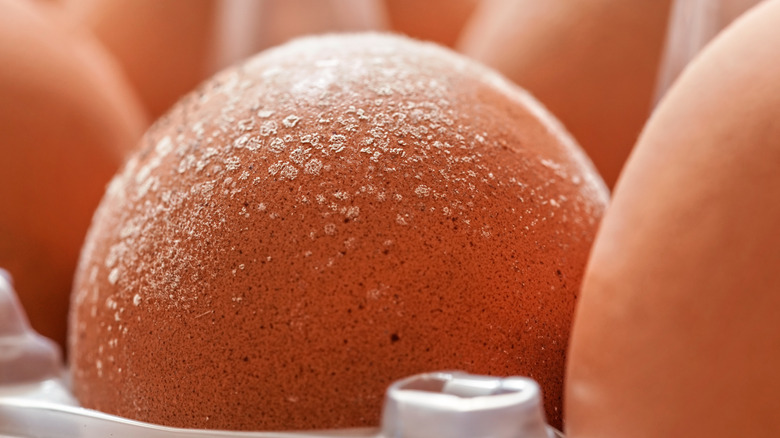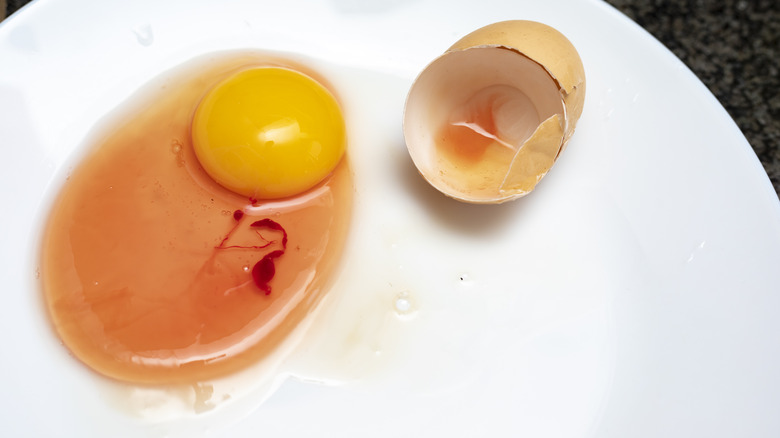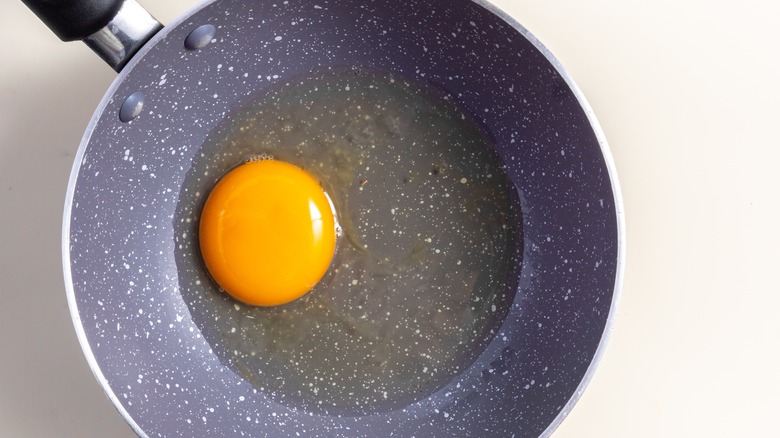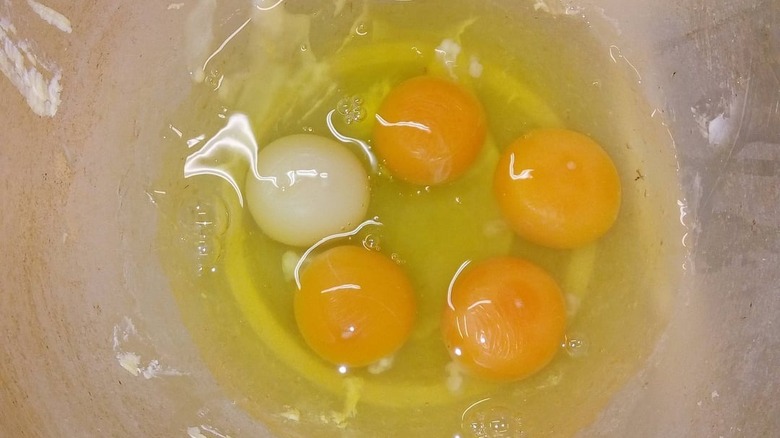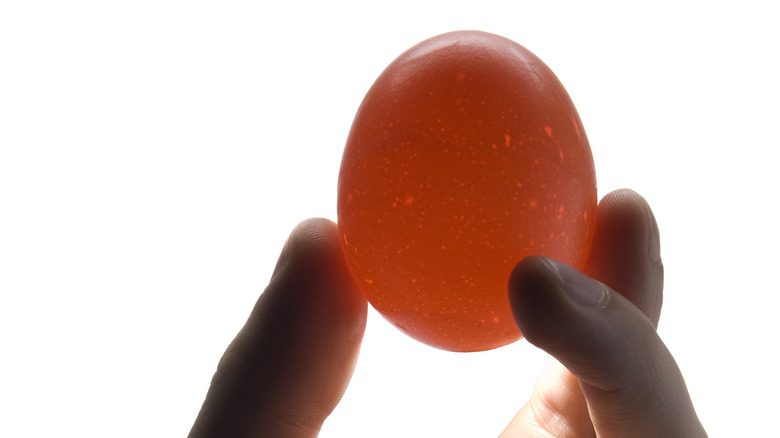11 Signs Eggs Are Not Safe To Eat
Eggs, the humble kitchen staple, have long been celebrated for their nutritional richness and wide array of uses. Whether scrambled, poached, or baked into a decadent cake, they offer a wealth of culinary possibilities. However, within these versatile cooking essentials can lurk potential hazards that threaten our health. While eggs are typically safe to consume, some unmistakable signs indicate they've gone bad, potentially harboring harmful bacteria. Recognizing these signs is crucial for protecting ourselves against foodborne illness and ensuring a safe dining experience.
Those who frequently enjoy these protein-packed gems should know when it's time to bid farewell to eggs past their prime. So, we're unveiling 11 tell-tale signs that your eggs may not be safe for consumption. From subtle changes in appearance to distinctive odors and textures, there are plenty of warnings to look out for, as well as tests you can perform to check for optimal freshness.
So, before you whip up a classic omelet, prep an egg salad, or crack those golden yolks into your cake mix, join us as we uncover the evidence that can mean trouble in your egg carton. Whether it's learning to recognize an obvious irregularity or a subtler cue, we leave no stone unturned in our quest to keep your kitchen — and your health — safe from potential harm.
1. Their expiry date has passed
When it comes to ensuring the freshness of eggs, the label on the carton is often the first point of reference. In many cases, there's either a sell-by or expiration date, depending on regional regulations. These dates are crucial in determining the freshness and safety of eggs, guiding consumers on when to use them to minimize health risks.
A sell-by date indicates the last day a store should sell the eggs for peak freshness. It serves as a guideline for retailers rather than consumers. Eggs are still safe to eat for a period after the date if stored properly. Meanwhile, an expiration date is the manufacturer's recommendation for the last day to consume the eggs for optimal taste and safety. It signifies the point at which the eggs may begin to deteriorate in quality and increase the risk of bacterial contamination. Consuming eggs after the expiration date could pose health risks. The lesser-known pack date reveals when the eggs were packaged or processed. It can also be useful for determining freshness, especially when there's no sell-by or expiration date available. Eggs are typically safe to eat for four to five weeks after the pack date if stored correctly.
Although useful indicators, blindly abiding by these dates is not always necessary. Eggs can often remain safe and perfectly edible for longer than indicated on the carton, so it can be helpful to combine this information with other signs that tell us about their freshness.
2. The shells appear broken or cracked
One of the most obvious signs that eggs may not be safe to eat is if their shells display visible cracks or breaks. The shell serves as the egg's primary defense against contaminants, so any damage to its integrity increases the risk of bacterial growth inside. In addition to compromising the contents, cracked shells can also impact freshness and overall quality, since the protective barrier that seals in moisture and prevents air from entering is damaged.
When inspecting eggs for cracks or breaks, make sure to examine them carefully from all angles. Sometimes, cracks may be small or not immediately visible. Running your fingers gently over the surface of the egg can help detect any irregularities in texture or structure. If you discover an egg with a cracked or broken shell, it's best to discard it rather than risk consuming contaminated or spoiled contents. While it may be tempting to try to salvage the egg by cooking it thoroughly, the risk of bacterial contamination remains high, especially if the egg has been sitting at room temperature for an extended period. To minimize the likelihood of encountering eggs with cracked shells, it's essential to handle them with care during storage and transportation.
3. The shells have a slimy coating
Another telltale sign of a spoiled egg is the presence of a slimy coating on its shell. This is likely to be indicative of bacterial contamination and spoilage, so make sure to exercise caution when handling. Discard it immediately and be sure to thoroughly wash your hands.
Consuming eggs infected with harmful bacteria like Salmonella, a common culprit associated with foodborne illness, poses a significant health risk. Salmonella can be present both on the shell of an egg and in the contents too. Symptoms of infection can range from gastrointestinal discomfort to more severe complications, particularly in vulnerable populations such as young children, the elderly, and individuals with weakened immune systems.
To mitigate the risk of bacterial contamination, stick to proper egg-handling practices. Storing eggs in the refrigerator at a consistent temperature of 40 degrees Fahrenheit or below helps prevent bacterial growth and prolongs their freshness.
4. There's a powdery substance on the shell
Encountering eggs with a powdery substance on the shell warrants caution, as it may indicate compromised quality or potential contamination with mold or fungus. Fungal infection may be visible as a green, powdery, or fuzzy black coating on the shell. Mold growth is most likely to occur if eggs have been stored in a warm, humid, or unhygienic environment during handling and transport. For this reason, it's important to store eggs in the refrigerator at a consistent temperature or away from areas prone to moisture, to prevent the growth of harmful molds and other fungi.
Mold species commonly observed on eggshells include Penicillium, Alternaria, and Rhizopus. As they proliferate, they can produce toxins that pose health risks if ingested. Though signs of mold are typically noticed on the shell first, it can also contaminate the contents of the egg. In this case, you might see black spots on the inside of the shell. An egg with this appearance could be dangerous to ingest, so it's best to swiftly dispose of it rather than risk potential illness.
5. They float in a bowl of water
If an egg is close to or only just past its expiry date and you're unsure about its quality, the water test is your go-to. This simple method is an effective way to assess the freshness of an egg, as it offers valuable clues about the internal condition based on buoyancy. Simply place the egg in a large bowl or tall glass of water. If it sinks and lays flat on the bottom, this indicates freshness. Fresh eggs have a higher density than water because there are fewer gases inside, causing them to easily sink.
As eggs age, they begin to decompose, producing gases that build up inside the egg. This results in a decreasing density which makes the eggs more buoyant. When placed in water, older eggs will tilt upwards or even float due to the larger gas bubble pushing them upwards. While eggs that float are not necessarily unsafe to eat, it's a sign that they aren't as fresh. The U.S. Department of Agriculture (USDA) suggests that a floating egg may still be perfectly safe to consume, but recommends cracking the egg open to check for unpleasant odors or visible signs of spoilage before deciding whether to use it.
6. There's an unpleasant smell
Perhaps the most powerful tool of them all for assessing egg freshness is your sense of smell. Fresh eggs typically have a neutral odor, so if you detect an unpleasant or foul smell emanating from an egg, it's a pretty strong sign that eating it is a no-go. With improper storage or age, bacterial growth can occur, leading to the breakdown of proteins and the release of toxic chemicals. The presence of a foul odor in eggs is often associated with the production of hydrogen sulfide, a particularly potent gas that your nostrils will certainly recognize.
If you're unsure about the smell of an intact egg, crack it into a bowl before you make a judgment. This should give you a more definitive answer as the sulfur-like smell of a bad egg will be pretty unmistakable. Trust your senses and refrain from eating an egg that gives off an offensive smell to avoid foodborne illness.
7. The egg whites appear green or pink
A visual inspection of the egg whites is another great way to determine the freshness and safety of eggs. Egg whites should have a clear or slightly translucent appearance, so the presence of green or pink discoloration is a real cause for concern that is often attributed to spoilage by bacteria such as Pseudomonas. As they multiply, this leads to the formation of pigments in the egg whites that can impart a pink or greenish hue. Eating an egg contaminated with Pseudomonas is likely to result in a pretty nasty case of food poisoning, with symptoms like diarrhea, vomiting, and stomach cramps.
It's essential to note that not all eggs with unusual discoloration are necessarily unsafe to eat. For example, the appearance of blood spots in the egg can be a sign of ruptured blood vessels in the yolk and does not pose any risks. Overcooking a boiled egg can also result in the formation of a green ring around the yolk. This is due to a reaction between sulfur in the egg white and iron in the yolk. Despite the slightly odd appearance, a yolk that's green simply because it's overcooked is fine to eat.
8. The egg white is runny and spreads a lot
A pink or green egg white seems like a pretty clear red flag, but what about if the texture is a little off? The consistency of an egg white is another important indicator of its freshness. While fresh whites are typically thick and viscous, the presence of a runny, watery consistency can signal potential issues with the quality.
When cracked open, a fresh egg white should hold its shape and not spread excessively, or else it may no longer be fresh. Commercial egg producers use egg white height as a measurement to determine freshness. Eggs are first weighed and then cracked so the height of the egg white can be measured. This produces a value in Haugh units which has a scale ranging from 0 to 110. According to The Poultry Site, a higher value means a fresher egg, with at least 60 Haugh units being a suitable value for selling.
Runny egg whites can result from storing the eggs at high temperatures or in an environment where the humidity is too low. It is important to note that not all eggs with runny whites are necessarily unsafe to eat. Some other factors, such as the age of the hen, can contribute to changes in consistency. However, if the runny texture is pronounced or accompanied by other signs of spoilage, it's best to discard the egg.
9. The egg yolk is flatter and discolored
When it comes to egg freshness, the appearance of the yolk can also give us important clues. Fresh egg yolks typically have a rounded, firm shape and a vibrant yellow or orange color. This sunny hue comes from the hens' diet, with corn and soy-fed hens producing more yellow yolks, and an orange tone resulting from a carotenoid-rich diet. However, a flattened or discolored yolk can indicate potential issues with the egg's quality.
When cracked open, a fresh egg's yolk should have an obvious domed shape. If the yolk appears flattened or sunken, it may suggest that the egg is no longer fresh. Additionally, a discolored yolk, such as one that appears pale or mottled, can also be a sign that something is amiss. This unsightly issue can occur when eggs are stored at high temperatures, or if hens have been fed a nutrient-poor diet or consumed certain types of medication.
Despite this, it can be tricky to ascertain whether a mottled yolk is unsafe to eat, as it's common for eggs to have some level of blotchiness. Older, staler eggs are however much more likely to have severe mottling, so this serves as a useful indicator.
10. They make a sound when you shake them
Though shaking an egg might seem like an odd way to gauge its freshness, it's another nifty method that can help you determine whether it's safe to eat. When you give an egg a gentle shake, you might notice something intriguing. If it's fresh, you won't hear much at all. But if it's not, you might just hear a faint sloshing sound.
Similar to the float test, the result you get is dependent on the build-up of gases inside the egg. Fresh eggs have a smaller, gas-filled air cell at their rounded end. But, as eggs age, that air cell expands, creating a bit of wiggle room inside the shell. When you shake them, there's more space for the liquid contents to slosh around and make a noise.
The shake test is a simple method that can be effective, but keep in mind that it isn't foolproof. The USDA does not recommend using this test alone to establish whether an egg is safe to eat. Some fresh eggs might still make a slight noise, and older eggs might not. But if you hear a noticeable sloshing sound, it's another sign the egg might be past its prime. Check it further by cracking it open and carrying out a visual inspection, as well as checking for bad odors. It could still be perfectly safe to eat, perhaps best reserved for scrambling or whipping up an omelet.
11. Shining a torch reveals a large air bubble
Another test that can shed light on whether an egg is safe for consumption is candling. This method involves shining a bright light onto an egg to see what's going on inside. Though commonly used by egg producers in a larger-scale factory setting, this technique can also be done at home. Simply find a dark spot, grab a bright torch or lamp, and hold it up to the egg.
When you shine a light through a less-than-fresh egg in a dim room, you might notice a sizable air bubble. Fresh eggs usually have a tiny air cell at one end, barely noticeable to the naked eye. But as we learned with the float and shake tests, this air pocket expands as eggs age. When you shine a torch at the shell, the light passes through the air cell, which will be more visible the larger it gets.
In commercial practice, the USDA uses a grading system that involves measuring the air cell depth. While there is an optimal depth, there is still a range deemed safe for consumption. This test is another great indicator of freshness, but a visible air cell is not a complete deal-breaker. Combine it with other tests before jumping to a decision. As long as the egg smells fine and doesn't show any other signs of spoilage, it's likely still safe to eat if cooked properly.




